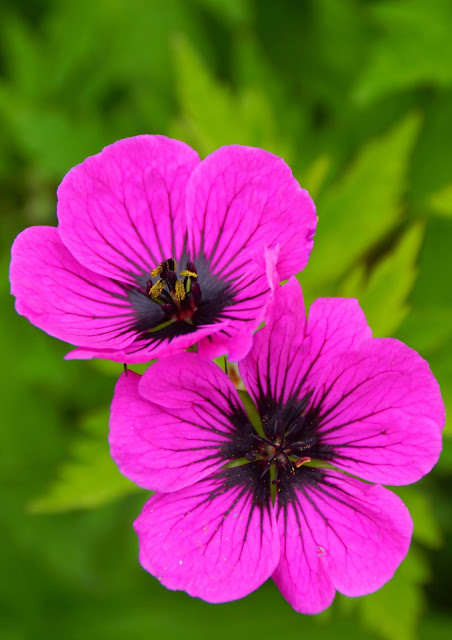Geranium are one of the most popular and common plants found in gardens where they are easy to grow and easily taken care of. They are a genus of 422 species of annual, biennial, and perennial plants commonly known as geraniums or cranesbills. They are a diverse genus found throughout the temperate regions of the world and the mountains of the tropics, but mostly in the eastern part of the Mediterranean region. There are several native species to the uk, including G.pratense, G sanguineum and G. robertianum, which have given rise to many named cultivars. It is reckoned the first geraniums introduced to Britain came in the late 16th century, followed by more species in the 1600's. Geranium sanguineum was cultivated in physic gardens for its wound healing properties, probably the reason for its common name "Bloody Cranesbill". Because of their scant usefulness geraniums probably weren't grown in gardens where space was only given to plants that could be eaten or had a use. Given their talent for seeding ans spreading Geraniums probably escaped from physic and botanic gardens fairly quickly, establishing themselves in hedgerows and gardens.
 |
| Geranium phaeum 'Mourning Widow' |
The flowers have five petals and are coloured white, pink, purple or blue, often with distinctive veining, appearing above palmately cleft leaves, usually broadly circular in shape. Geraniums will grow in any soil as long as it is not waterlogged. Here I am going to talk about perennial geraniums, often referred to as herbaceous geraniums and not to be confused with the tender Pelargoniums, often referred to as geraniums. Herbaceous Geraniums are great plants for all gardens and will tolerate often quite challenging garden conditions, growing in sun, shade or poor soil. It is a tough, hardy and long living plant and doesn't need staking or fussing. Most will produce a second flush of flowers if cut back after their first flowering in May or June.
 |
| The flowers of Geranium x monacense 'Claudine Dupont' |
 |
| Geranium sylvaticum 'Album' |
 |
| Geranium phaeum var. phaeum 'Samobor', Quercus |
 |
| Geranium Kashmir Purple, Persicaria 'Inverleith' and Primula floridae |
 |
| Bee on Geranium 'Mrs Kendal Clark' |
 |
| Geranium x monacense 'Claudine Dupont' |
Geranium clarkei ‘Kashmir Purple’ - Another spreading variety with dainty mid purple flowers veined purple in summer. Leaves are attractive in their own right before the plant flowers with filigree cut leaves. Prefers moderately fertile soil in full sun or partial shade. Height 45cm.
Geranium dalmaticum - Dwarf, creeping plant with glossy evergreen, aromatic leaves and long stalked clusters of pink flowers with red anthers in summer. Some reddening of the leaf in autumn. Light shade and moist soil but well-drained soil. Great ground cover plant. H 15cm, S 1m.
Geranium macrorrhizum 'Freundorf' - A good variety with pink flowers and good autumn colour. Ideal for dry shade but will tolerate a range of growing conditions. Great ground cover. H 30cm, S 60cm.
Geranium nodosum - A spreading Geranium with bright glossy green, divided leaves and funnel-shaped lilac-pink or pink, lightly veined flowers from May to September. Ideal for shade. H 20cm, S 45cm.
Geranium phaeum ‘Samobor’ - Bushy, early blooming species with fully opened very dark purple flowers and pale green leaves ageing dark green with large chocolate blotches on the leaves. Best in moist shade but will tolerate dryness under trees. H60cm, S 30cm.
Geranium ‘Philippe Vapelle’ - Velvety, grey green leaves like G. renardii, but big wide sky-blue flowers with darker veining throughout summer. Sun or partial shade in well drained soil. 35cm.
Geranium pratense - Meadow cranesbill. A native clump-forming plant with hairy stems and deeply-lobed foliage. The saucer-shaped, white, blue or violet flowers are 4cm across and appear in early to mid-summer. Will tolerate sun or partial shade and most soils. H 70cm, S 50cm.
Geranium sanguineum 'Aviemore' - An attractive, slowly spreading plant for the front of the border or alongside a path. Purplish-pink flowers appear all summer from June onwards over dissected mid-green foliage. H 20cm, S45cm.
Geranium sanguineum var. striatum AGM - One of the prettiest of British native plants. Shallow, cup-shaped, rose-pink flowers, pencilled crimson, are effective against the dissected, dark-green leaves at the front of the border or with a multitude of other perennials in early to mid-summer. Lovely with blue grasses and purple foliage. H 20cm, S45cm.
Geranium ‘Sirak’ AGM - A sprawling geranium with distinct, vibrant, mauve-pink flowers, emerging from hairy buds in late spring and continuing into summer with often a second flush of flowers later. Plant in sun or partial shade in well drained soil. H 65cm, S 60cm.#
Geranium x monacense ‘Claudine Dupont’ - A dusky pink-purple spring flowering Geranium with slightly reflexed petaled flowers with a white eye and a ring of smoky blue eye-liner. The leaves appear in a generous clump of bright yellow foliage that fades to green in summer. Each leaf is marked with strong maroon blotches and stand well in shade, even if dry. Really brightens up a shady corner. Height 45cm, Spread 60cm.
 |
| Geranium psilostemon |
 |
| Geranium x oxonianum 'Wargrave Pink' |
 |
| Geranium 'Mayflower' |
Follow us on Instagram @quirkybirdgardener
Such good doers in every situation
ReplyDeleteLinda, they are, I love them, and so many variations too
Delete